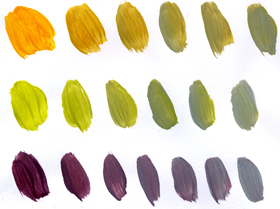In the workshop we spent a good deal of time investigating the colours you can mix from blue, red, yellow, white, and black. Mixing roughly equal amounts of the three primaries gives you brown - but there is a wide range of possible browns you can get. Since brown is a very common colour in nature and so in still life painting, it is worth spending time mixing as many browns as children can find.
They can first try various combinations of the primaries, to get red-brown, orange-brown, yellow-brown, green-brown, blue-brown, and violet-brown. Then they can add varying amounts of black to each of these to get darker browns. Then they can add varying amounts of white to get lighter hues. Finally they can add both black and white - i.e. grey - to the browns to get dirty browns. These are common in nature.
Brown plus white Brown plus black


2. Greys
In the workshop we discussed two of the three dimensions of colour - hue and tone. The third dimension is usually called saturation, and it means the intensity of colour, versus the amount of grey added. A colour can range from the pure hue to almost entirely grey. You can have a range of reds, therefore, from pure red to very grey red, depending on how much grey you add. So there is an enormous range of colours you can mix with just the five hues used in the workshop.
Primary colours plus grey Secondary colours plus grey


3. Broadening the Palette
We used only 5 colours in the workshop, from which many were mixed. But of course most artists use a lot more than only 5 colours. You may have noticed that the greens you can get from yellow and blue are very limited. There are lots of other greens possible, but you need to supply green paint. Children can try mixing a new green colour with all the others to again see what range of colours they can get. You could also add other colours which can't be mixed using only the basic five - like magenta, other purples, turquoise, and certain browns. Generally, however, if a painting has a very wide range of colours used for mixing it can look garish and unattractive. A limited palette can work very well.
4. Monochrome Paintings
To teach mixing colour tones, children can try doing a painting using only one hue plus black and white. You can get interesting effects by for example painting only shades of green. This will help teach seeing these tones too.
5. Copying the Masters
A valuable exercise in learning how to mix and to use colours in more subtle and powerful ways is to make a copy of a great painting. This does mean you will need to have a colour version of the painting for everyone (perhaps from a textbook?). This exercise will also help children learn about different styles of art. A similar exercise is to make a painting in the style of an artist, but not necessarily a direct copy. In many schools, for example, I have seen versions of Van Gogh's chair.
6. Complementary Colours
Children can try making a painting which uses the concept of complementary colours. They should not try to copy the colours of their objects literally but use colours such as red and green (in various tones and slight variations of hue). Complementary colours often look vibrant together and bring a painting alive.

Van Gogh, L'Arlesienne
- using yellow and violet complementary colours
(and also red and green with the book and table)
7. Colour Planes
Children can try a very different style of painting, in which colour is the main focus, rather than tone or form. Matisse is famous for his paintings in which there is much less attempt at shading to give a '3D' look to objects. Instead there are planes of colour, used very effectively. Children can try their own still life in this style. You might want to show them some Matisse paintings first.

Matisse, Still Life with Vegetables